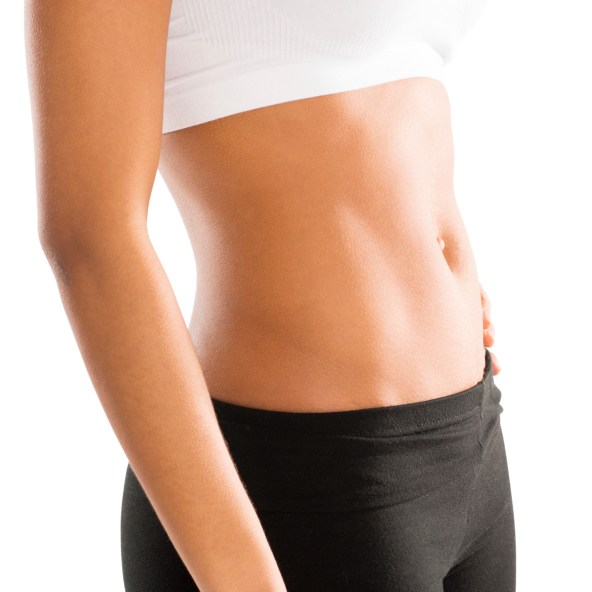What I Tell My Patients Who Want To Lose Belly Fat: A Hormone Expert Explains

Get glowing skin, deeper sleep & better digestion.
Preview latest class for free

Dr. Sara Gottfried is a Harvard-trained MD, best-selling author, and leading expert on hormones. Now, she's teaming up with mindbodygreen to share her secrets. Check out her new course, How to Balance Your Hormones for Glowing Skin, Deeper Sleep & Better Digestion.
When you gain excess weight, particularly at the waist, your body’s biochemistry spirals downward. You create more inflammation and oxidative stress, and promote even more fat storage. The result is a vicious cycle of hormonal misfires, symptoms, and disease that will drag you down unless you flip the switch.
In your belly, you have two types of fat: subcutaneous and visceral. Subcutaneous is more external; the type you can pinch with your fingers. Visceral fat is deeper and more ominous, and you’ll find it stored around and even inside some of your organs, such as the liver, kidneys, intestines, and pancreas. Think of it as a bad biochemical broth that bathes your innocent cells.
Calories matter—but hormones matter more.

I thought I had the usual amount of subcutaneous and visceral fat—until I measured it about three years ago. I was unprepared for the results: I didn’t have a beer belly, but I enjoyed a glass of wine or two most nights. I was disgusted yet intrigued to find that most of my body fat was concentrated in my belly, i.e., I had the wrong kind of junk in my trunk. I took it one step further and measured my liver enzymes, which confirmed that I had fatty liver (my alanine aminotransferase or ALT was > 20 U/L, the cutoff for women. For men, the cutoff is > 30 U/L). So I made it my mission to get the junk out of my trunk. You may also have this problem, and not know it.
We’re anciently wired to store belly fat in response to eating sugar, which allows the body to survive the winter when food is scarce. But in times of abundant food, that ancient wiring backfires, and you store fat despite the lack of famine. The key is to reverse the hormonal misfires, thereby arresting cravings and belly fat storage.
If you want to burn belly fat, there are 10 key strategies to implement, and most involve food. These are the same strategies that I applied to my own body to cut visceral fat.
Keep in mind that not all calories are the same. Calories from some foods make you store belly fat—like excess carbohydrates—while other foods make you store muscle and burn fat. And while calories matter, hormones matter more. In particular, reducing your belly fat involves the reset of the belly fat hormones: insulin, leptin, cortisol, growth hormone and adiponectin.
1. Add purslane to your salad.
Most people have no idea what purslane is. I didn’t either until I discovered my problem with eating excess fructose and how it contributes to fatty liver, among other problems.
So I decided to up my omega-3s, particularly since an omega-3 fatty acid known as docosahexaenoic acid, or DHA, seems to reverse the harmful changes to belly fat produced by fructose. In fact, DHA doesn’t just change one or two genes, it pushes an entire block of genes back to normal.
Purslane offers the richest source of omega-3s and melatonin that you can obtain from a green vegetable—mostly alpha linolenic acid (ALA), which can be converted into DHA. One chef calls it a miniature jade plant. I call it a super food, a weed worth eating, because its nutrient density strengthens synapses, or connections in your brain, and enhances memory and learning.
I grow it in my garden, then chop it in salads or add it to soups at the very end. You can grow it too, or buy it at your local farmer’s market, next to the sorrel and nettles.
2. Do high-intensity interval training (HIIT).
Before my segmented body fat composition test, I was a chronic cardio girl. I would go running for an hour, four times per week. I was stressed and felt victim to time compression: there was no time for other less efficient activities like Pilates or free weights. Then I realized my running was raising my cortisol levels and adding to my belly fat. In fact, my cortisol was three times the normal level in the morning, before my run—so I was like a perpetual high-cortisol machine.
After a bit of research, I had an epiphany. I needed to burst train, or repeatedly exercise at a high intensity for 30 to 75 seconds, separated by two to three minutes of recovery. Burst trainers have far more fat loss compared with endurance trainers.
3. Skip the booze.
Unfortunately, liquid calories from soda, juice, and yes, alcohol, lay down belly fat. Do you want alcohol or abs?
4. Eat sufficient clean protein.
Undereating protein and overeating carbs can lead to weight gain. Make sure your protein is anti-inflammatory, i.e., lentils and other legumes, if you tolerate them; cold-water, low-mercury, wild-caught seafood like salmon, cod, and steelhead trout; and pastured and wild meats, if you eat them, like elk, bison, and grass-fed beef.
5. Remove the most common food intolerances: gluten and dairy.
This isn’t just a fad—research suggests that going gluten-free can reduce fatness, inflammation, and insulin resistance. We know that food intolerances tend to raise stress hormones, such as cortisol, trigger inflammation, and overactivate the immune system.
6. Limit fructose and glucose (but for different reasons).
Fructose is the most metabolically hurtful sugar. It goes straight to your liver, where it makes fat and triggers insulin and leptin resistance. Fructose doesn’t tell your brain that you’re satisfied, so you still feel hungry and keep eating. The net result is inflammation, a stressed-out liver, and more visceral fat.
The main culprit for most Americans is excessive amounts of high fructose corn syrup—the Department of Agriculture estimates that Americans consumed an average of about 27 pounds of high-fructose corn syrup in 2014—but I found that I probably have a problem with even higher-fructose fruit such as bananas, dates, and dried apricots.
The main takeaway is that in contrast to glucose, fructose doesn’t trigger insulin secretion or leptin production. These two hormones dampen appetite by telling your body you’re full and to put the fork down. Limit your fruits to lemons, limes, avocados, and olives. Dial down the fructose to lose belly fat. I’ll discuss the daily limit that I recommend for 21 days in our upcoming webinar.
7. Wrangle cortisol.
If you perceive that life is stressful, you’re more likely to store fat, gain weight, and break down muscle. I know you know this, but it’s worth repeating because I certainly need a daily reminder!
What works best is a daily practice of 30 minutes to reset stress levels in the body. Stress raises your pesky hormone cortisol, which breaks down muscle and stores fat. Listen to a guided meditation by Tara Brach on the free app Insight Timer, get a massage, have an orgasm, or walk your dog around the block. Figure out what works for you and do it regularly.
8. Get your belly rest.
You need 7 to 8.5 hours of uninterrupted sleep to burn visceral fat. Sleep keeps cortisol and insulin in check.
9. Raise adiponectin.
Adiponectin is part of a secret conversation between your fat cells and your brain. When levels are low, adiponectin can make you store fat. The more adiponectin you have in your blood, the more flab you burn.
To raise adiponectin, eat pistachios and pumpkin seeds, get 35 to 50 grams of fiber per day, and consider taking a magnesium supplement.
10. Try a mini fast.
Intermittent fasting works as well as caloric restriction (no, thank you!) for reducing visceral fat. The goal is to create a fasting window that burns fat. Unfortunately, women need to work a little harder than men for the same benefit: for women, aim for an 18-hour window; for guys, 16 hours.
-
Will The Real Fitness Hormone Please Stand Up
New Medical Research shows high-intensity exercise can increase the bo
-
Do Fad Diets Work?
Fad diets are weight loss plans that promise amazingly fast result
-
How Effective Are The Various Types Of Pest Control
When spring and summer roll around along with the wonderful sunny day
-
How To Get Your Sweet Fix Safely
If you could make one simple change in your diet to help you melt f
-
Is Fat the Key to Losing Weight?
Since the fat-free craze began, statisti
-
Roadblocks To Weight Loss And What Really Works
Obesity is an epidemic. A couple of deca
- DON'T MISS
- Eating The Right Way Towards A Healthy Weight Loss
- 10 Simple Steps To Weight Loss (And A Healthier Life)
- Cycling For Weight Loss
- Lose Those Last Ten Pounds
- Be Careful About Using Weight Loss Laxatives
- How to Lose Weight Fast Without Starving Yourself
- A Mindful Chocolate Meditation
- What Exactly Should We Look For From The Best Weight Loss Products?
- 4 Empowering Solutions to Take Back Control of Your Body & Self-Esteem
- Life After Weight Loss Surgery - Don't Let Shame and Self-blame Weigh You Down




